International Rules and e-Commerce: Trade Insight, Vol. 15 No. 1–2, 2019Trade Insight is published by the South Asia Watch on Trade, Economics and Environment. This issue includes discussions on various aspects of e-commerce, such as cryptocurrencies, integration of small and medium enterprises, and competition and regulation. Its editorial argues that South Asia should take an active part in drafting global rules on e-commerce. The issue also includes features on the South Asian Association for Regional Cooperation investment agreement, Connectivity 2.0 for the South Asia Economic Union, the use of inland waterways, and the electronic cargo tracking system. Author: South Asia Watch on Trade, Economics and Environment Year: 2019 Download Tags: Electronic Cargo Tracking System, SAARC, Trade, Transport Asia-Pacific Trade and Investment Report 2018: Recent Trends and DevelopmentsThe Asia-Pacific Trade and Investment Report provides information and independent analyses of regional trends and policy developments in trade, goods, and commercial services. In 2018, the Asia-Pacific region increased its share of global merchandise trade. Intraregional and interregional trade also accelerated in Asia-Pacific. As trade among and with North, Central, and South Asia still involve high costs, more cooperation is needed on digitalization of trade processes. Author: United Nations Economic and Social Commission for Asia and the Pacific Year: 2018 Download Tags: South Asia, Trade Facilitation Agreement, WTO, SAARC, UNESCAP 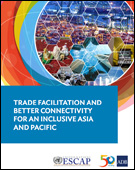 Trade Facilitation and Better Connectivity for an Inclusive Asia and PacificThis report investigates the evolution of trade costs, examines trade facilitation and paperless trade implementation, and highlights key initiatives in South Asia, including efforts by members of the South Asia Subregional Economic Cooperation (SASEC). The SASEC Trade Facilitation and Transport Working Group agreed to expand assistance to trade facilitation through technical assistance to support more efficient, transparent, secure, and service-oriented processing of cross-border trade across South Asia. Through 2025, the SASEC connectivity agenda will be better aligned with the frameworks of South Asian Association for Regional Cooperation and the Bengal Initiative for Multi-Sectoral Technical and Economic Cooperation. To help establish a trade and transport facilitation monitoring mechanism, Bangladesh, Bhutan, and Nepal conducted studies that reviewed trade and transport procedures, analyzed bottlenecks, and gave recommendations on trade and transport facilitation. Author: Asian Development Bank and United Nations Economic and Social Commission for Asia and the Pacific Year: 2017 Download Tags: ADB, Bangladesh, Bhutan, BIMSTEC, Maldives, Nepal, SAARC, India, Myanmar, SASEC, South Asia, Sri Lanka, Trade Facilitation, Transport, UNESCAP, ADB RCI 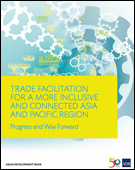 Trade Facilitation for a More Inclusive and Connected Asia and Pacific Region: Progress and Way ForwardThis report gives an overview of assessments from the 2017 global survey on trade facilitation and paperless trade in Asia and the Pacific. It looks at the implementation of trade facilitation and paperless trade measures in 44 countries in Asia and the Pacific, including how the South Asia Subregional Economic Cooperation Trade Facilitation Strategic Framework promotes development by deepening regional cooperation. The Framework covers national and subregional projects in Customs harmonization, improving cross-border facilities, and transport facilitation. The Framework also supports regulatory reforms and the development of the National Single Window Customs management system in Bangladesh, Bhutan, Maldives, and Nepal. Author: Asian Development Bank and United Nations Economic and Social Commission for Asia and the Pacific Year: 2017 Download Tags: ADB, Bangladesh, Bhutan, BIMSTEC, Maldives, Nepal, Regional Cooperation, Regional Integration, SAARC, SASEC, Standards Harmonization, Trade Facilitation, Trade Facilitation Agreement, WTO, UNESCAP, ADB RCI Regional Road Map for Implementing the 2030 Agenda for Sustainable Development in Asia and the PacificIn 2015, 150 countries set in motion the most ambitious development agenda of our time, the 2030 Agenda for Sustainable Development. Asian countries have begun translating this agenda into action through national plans and programs. However, to fully achieve the Sustainable Development Goals, countries need to examine opportunities for regional cooperation to complement the effectiveness of national mechanisms in the areas of finance, technology, capacity-building, and trade. Discussion through regional and subregional organizations can help facilitate cooperation in these key areas. Author: United Nations Economic and Social Commission for Asia and the Pacific Year: 2017 Download Tags: Regional Cooperation, SAARC, Sustainable Development Goals, Trade, UNESCAP SARSO News: Vol. 31, No. 2The South Asian Regional Standards Organization (SARSO) newsletter features updates on SARSO events and activities. This issue features the publication of three South Asian Association for Regional Cooperation standards on food quality and safety, and the workshop on the importance of ISO 14001—which aims to help organizations improve environmental performance through the efficient use of resources and reduction of waste—and its impact on the environment and trade. It also has reports on Workshop on Conformity Standards held in New Delhi, India, and the Enhancing Capacity for Sanitary and Phytosanitary (SPS) Measures for Safe Trade in Animal and Animal Products in South Asia held in Kathmandu, Nepal. Author: South Asian Regional Standards Organization Year: 2017 Download Tags: Agriculture, Bangladesh, Bhutan, India, Nepal, SAARC, SARSO, South Asia, Standardization, Trade 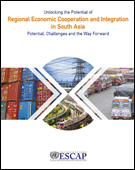 Unlocking the Potential of Regional Economic Cooperation and Integration in South AsiaAt a modest 6% of total trade, intraregional trade in South Asia stands at less than one third of its full potential. Trade barriers and inadequate infrastructure have cost South Asia over US $54 billion per year in lost export opportunities. With 309 million people living on less than $1.90 a day—the largest concentration of poverty in the world—South Asia should urgently pursue broad-based regional economic cooperation that could enable effective responses to the subregion’s developmental challenges. This report examines the state of economic integration in South Asia and identifies potential areas for further strengthening subregional linkages. It provides recommendations on policy actions to increase market integration, improve connectivity, boost investment in infrastructure development, and tackle shared vulnerabilities and risks. It calls for the consolidation and upgrading of existing trade and investment cooperation initiatives into a South Asia Comprehensive Economic Partnership. Author: United Nations Economic and Social Commission for Asia and the Pacific Year: 2017 Download Tags: BIMSTEC, Investment, Regional Cooperation, SAARC, South Asia, Sustainability, Sustainable Development, Trade, UNESCAP, Bangladesh, Bhutan, India, Maldives, Myanmar, Nepal, Sri Lanka For a Shared Future of South Asia: Trade Insight, Vol. 12, No. 3This volume focuses on the South Asian Association for Regional Cooperation (SAARC) as a means for fostering regional cooperation to increase stability and development in the region. It urges SAARC member countries to cooperate, highlighting how economic integration and involving non-state actors can strengthen overall cooperation in South Asia, and help secure regional peace and security. It includes a discussion on the Bangladesh-Bhutan-India-Nepal as an economic corridor, South Asian drivers of regional integration, and the Belt and Road initiative. Author: South Asia Watch on Trade, Economics, and Environment Year: 2016 Download Tags: SAARC, Regional Cooperation, BBIN Study for Development of a Potential Hydropower Plant in South AsiaRapid development in South Asia has produced a huge surge in energy demand. Nepal, with more than 83,000 megawatts of potential hydropower supply, can significantly increase the South Asian Association for Regional Cooperation (SAARC) region's energy security. This study highlights ongoing hydropower projects in Nepal, in particular, the Sunkoshi 2 Storage Project, which has the potential to become a regional hydropower plant in South Asia. It also emphasizes the need to expand the region's power transmission infrastructure to promote power trade, and updating of policies that govern cross-border electricity trade among countries in the region. Author: SAARC Energy Centre Year: 2016 Download Tags: Hydropower, Energy, Nepal, SAARC, Trade Capital Market Integration in South AsiaThis book discusses the potential capital market products and activities within South Asia that stakeholders in the region could explore to help the South Asian Association for Regional Cooperation (SAARC) region further realize its potential. Conventional investment, such as funds, global depository receipts, as well as promising opportunities that factor the region's demographics and socioeonomics are considered in this book, with arguments aimed toward investors and institutions. The book demonstrates both retail and institutional investor interest in this combined high-growth region by offering scope for yield, diversification and risk mitigation, maximized upside from multiple growth markets, minimized downside through low-correlation constituents, and makes the case why now is an opportune time to look at SAARC. Author: Sourajit Aiyer Year: 2016 Download Tags: Investment, SAARC, Trade, Economic Corridor SARSO News Volume 2, Issue 2The South Asian Regional Standards Organization (SARSO) newsletter features updates on SARSO events and activities. This issue highlights initiatives by SARSO to harmonize standards and improve conformity assessment in the region through workshops, and also meetings of its sectoral technical committees. It also discusses the Cooperation Agreement signed by SARSO and the International Organization for Standardization, to help facilitate the flow of goods and services, and participation of SARSO in a meeting organized by the private sector on 'Promoting Trade in Bangladesh-Bhutan-India-Nepal' region. Author: South Asian Regional Standards Organization Year: 2016 Download Tags: Standards, Trade Facilitation, SAARC, BBIN, South Asia Thirty Years of SAARC: Society, Culture and DevelopmentThis book traces economic and political issues through SAARC’s 30-year journey. The collection provides a well-researched assessment of SAARC, looks at policy directives for the future, and examines constraints to cooperation in South Asia. The publication argues that countries need to consider the benefits of economic cooperation if they wish to play an increased role in globalization. Author: Rajiv Kumar and Omita Goyal, editors Year: 2016 Download Tags: SAARC, Regional Cooperation, Development 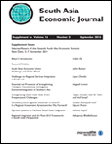 South Asia Economic Journal: Supplement Issue: Papers of the Seventh South Asia Economic SummitThis special issue of the South Asia Economic Journal contains papers presented at the 7th South Asia Economic Summit. With South Asia moving toward a South Asia Economic Union (SAEU), several major challenges remain, including reduction in the sensitive list, removal of Non-Tariff Barriers, effective and faster implementation of the South Asian Agreement on Trade in Services, effective regional investment cooperation, promotion of trade facilitation measures, promotion of regional value chains, cross-border energy cooperation. The articles in this volume tackle these critical issues to develop a way forward and generate ideas on policy priorities. A paper by Mr. Nagesh Kumar, UNESCAP-SSWA, on 'Potential and Prospects of Strengthening Transport Connectivity for Regional Economic Integration in Southern Asia' also discusses how two planned extended transport corridors can only facilitate trade and draw South Asia closer to its potential to become a hub of Asia–Europe trade. Author: Prabir De, editor Year: 2015 Download Tags: SAARC, South Asian Economic Union, Trade Facilitation, Transport Reducing Non-Tariff Barriers to Food Trade Between India and South Asia: Eliminating Phyto-Sanitary and Sanitary IssuesThis brief focuses on the impact of phyto-sanitary and sanitary measures as a significant non-tariff barrier to trade at India's overland trading posts and ports, from which it imports perishable goods from its neighbors in the SAARC region. Due to inadequate facilities to handle large, time-sensitive, and perishable consignments, India and its neighboring trade partners have experienced severe constraints on bilateral trade, which results to variability in time and cost of freight movement, and eventually affects price stability and availability of India's food stocks. Author: Hemant Shivakumar and Shiva C. Sharma Year: 2015 Download Tags: Sanitary and Phytosanitary Measures, India, SAARC, Trade, Non-Tariff Measures, Bangladesh Cross-Border Power Trading in South Asia: A Techno Economic RationaleSouth Asian countries have a wealth of diverse energy sources. These renewable resources, along with the varying electricity demand patterns among countries in South Asia, open up opportunities to share resources through electricity trading, which can be enabled by strengthening the electricity transmission system. This study examines the cost and benefit of six cross-border electricity transmission interconnections, and measures the economic and reliability benefits for participating countries in South Asia. Author: Priyantha Wijayatunga, D. Chattopadhyay and P. N. Fernando Year: 2015 Download Tags: Energy, SAARC, Regional Trade, ADB, ADB RCI SAARC: The Way AheadThis Observer Research Foundation Issue Brief examines the South Asia Association for Regional Cooperation as a regional grouping that is almost three decades old. It discusses trade arrangements such as the South Asian Preferential Trading Arrangement aimed towards a higher level of intraregional trade liberalization and economic cooperation, including the South Asia Free Trade Area for reduction of Customs duties on traded goods. The paper further studies areas of energy, connectivity, foreign direct investment, trade in services and subregional cooperation. The South Asia Subregional Economic Cooperation Program is offered as one of the steps in the direction of having a viable option for subregional cooperation. Author: Jayshree Sengupta Year: 2015 Download Tags: Regional Cooperation, SAARC, Trade, Connectivity, Energy, FDI, Investment, Free Trade Agreements, Services, South Asia A Critical Disconnect: The Role of SAARC in Building the DRM Capacities of South Asian Countries This report evaluates the disaster risk management (DRM) efforts of the South Asian Association for Regional Cooperation (SAARC) in the last ten years as a regional organization, and assesses its impact in supporting the DRM national capacities of member states. Published after the April 2015 earthquake in Nepal, the publication underscores the critical role SAARC plays in building a common regional vision for DRM. It recommends focusing on priority activities that can assist member states in implementation of policies at a sub-national level; opening itself to support by external donors; and enhancing its training program through regional training of trainers by the SAARC Environment and Disaster Management Centre. Author: Stacey White Year: 2015 Download Tags: SAARC, Disaster Risk, South Asia Regional Transit Agreement in South Asia: An Empirical InvestigationThis discussion paper published by the South Asia Watch on Trade, Economics and Environment assesses the potential gains of a sub-regional transit arrangement and the removal of other border-trade barriers, particularly the eastern South Asia sub-region (Bangladesh, Bhutan, India and Nepal). It also discusses the link between transit and trade flows, provides profiles of intra-regional transit trade and current transit arrangements in South Asia, and identifies efficient regional transit corridors using linear programming or the Data Envelopment Analysis model. Author: Prabir De and Arvind Kumar Year: 2014 Download Tags: South Asia, Trade, Transport, Economics, Economic Corridor, SASEC, SAARC, UNESCAP, Customs, Harmonisation, Bangladesh, Bhutan, India, Nepal, Maldives, Sri Lanka NTMs in South Asia: Assessment and AnalysisThe study “NTMs in South Asia: Assessment and Analysis” analyzes how Non-tariff Measures (NTMs) give rise to non-tariff barriers, which are becoming increasingly crucial for advancing trade cooperation among member countries of the South Asian Association for Regional Cooperation, yet remain less-addressed. The study examines export potential and actual export of South Asian countries, and attempts to highlight gains from reduction in transaction costs in bilateral trade. It also notes that initiatives for trade facilitation reforms in South Asia at the regional level remain low in incentives and have yet to produce significant results. The study closes with several recommendations for reducing and eliminating NTMs. Author: Selim Raihan, Mostafa Abid Khan, and Shaquib Quoreshi Year: 2014 Download Tags: Trade Facilitation, Trade, SAARC, Bangladesh, Bhutan, India, Maldives, Nepal, South Asia, Sri Lanka  The Connectivity AgendaThis article appeared in the special issue of My Republica published on the occasion of the 18th SAARC Summit. Mr. Ronald Antonio Q. Butiong, Unit head of the South Asia Subregional Economic Cooperation (SASEC) Regional Cooperation and Operations Coordination Division of the Asian Development Bank (ADB), traces the blueprints of SASEC projects to the South Asian Association for Regional Cooperation (SAARC) Regional Multimodal Transport Study (2006) and SAARC Regional Energy Trade Study (2010); two studies supported by ADB and endorsed by SAARC member states. Highlighting the SASEC focus to promote economic cooperation in the subregion by developing cross-border connectivity and facilitating intra-regional trade in South Asia through its priority sectors—energy, transport, and trade facilitation—Mr. Butiong explains how ADB is providing assistance to sections of Bangladesh, Bhutan, India, and Nepal along SAARC corridors through SASEC. Featuring a brief discussion of key SASEC projects and technical assistance (since 2001, 33 projects implemented, worth over US$6 billion) alongside institution and capacity-building support, the article shows how the SASEC connectivity agenda is part of achieving SAARC development objectives. Author: Ronald Antonio Q. Butiong Year: 2014 Download Tags: SAARC, Energy, Transport, Trade Facilitation 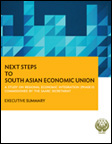 Next Steps to South Asian Economic UnionThis executive summary focuses on Phase II of the study on Regional Economic Integration, commissioned by the South Asian Association for Regional Cooperation (SAARC) Secretariat with the technical and financial assistance of the Asian Development Bank, and outlines a roadmap toward a South Asian Economic Union (SAEU). It presents an overview of intra-regional trade in South Asia—with India accounting for 65% of the region's combined total exports, and Sri Lanka 24% of total intra-regional imports—and discusses specific priority steps, using a phased and planned approach that quantifies potential gains from priority sectors identified in Phase I, needed to achieve regional economic integration. Thus, while non-tariff barriers, infrastructure constraints and other factors continue to challenge regional cooperation and integration in South Asia, reference by SAARC leaders toward an SAEU indicates a willingness to consider bold action. Author: Asian Development Bank Year: 2014 Download Tags: SAARC, South Asian Economic Union, Economic Integration, Bangladesh, Bhutan, India, Maldives, Nepal, Sri Lanka, Regional Integration 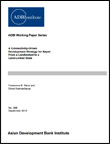 A Connectivity-Driven Development Strategy for Nepal: From a Landlocked to a Land-Linked StateTransforming Nepal from a landlocked into a land-linked state, the authors argue, could be key to unlocking the country's much-awaited growth. With its strategic location between India and the People's Republic of China, a connectivity-driven development strategy could energize Nepal's lackluster post-conflict economic performance. Further, Nepal implements a multi-track approach to promoting regional cooperation and integration in connectivity with its neighbors, reinforced through participation in South Asian Association for Regional Cooperation, Bay of Bengal Initiative for Multi-Sectoral Technical and Economic Cooperation, and South Asia Subregional Economic Cooperation. By identifying ten priority projects that could further boost Nepal's connectivity, the paper also discusses how strengthening Nepal's transport, energy, and trade links could benefit the region. However, the authors also warn against “internal threats” to Nepal's development—corruption and the country's difficult political situation. Author: Pradumna B. Rana and Binod Karmacharya Year: 2014 Download Tags: Nepal, Economic Corridor, Regional Trade, Connectivity, Development, Economic Growth, SASEC, India, Regional Cooperation, Regional Integration, SAARC, BIMSTEC, Transport, Energy, Trade 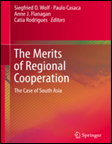 The Merits of Regional Cooperation: The Case of South AsiaThis book makes the case for a re-strengthened South Asian Association for Regional Cooperation (SAARC), arguing that regional integration is a key factor for countries in South Asia to succeed economically and increase confidence among potential foreign investors. SAARC's inroads in improving border crossings, transport routes, and infrastructure are improving weak levels of trade within the region. However, these efforts are insufficient; they need to go hand-in-hand with further improving bilateral relations – and SAARC is in a good position to facilitate these negotiations. Spanning a wide range of subjects, including international relations, strategic affairs, environment, politics and economic issues, the publication aims to show the huge potential of South Asia as a region. Author: Siegfried O. Wolf, Paulo Casaca, Anne J. Flanagan, and Cátia Rodrigues Year: 2014 Download Tags: Regional Cooperation, ASEAN, Bangladesh, Europe, India, SAARC, South Asia SAARC Biz: The Inevitability of South Asia SAARC Biz is a monthly publication of the SAARC Chamber of Commerce & Industry and features a report on the 'Inevitability of South Asia'. While the term 'South Asia' is commonly accepted, it argues that regionalism is far from being implemented on the ground. For instance, SAARC was accepted as a concept of cross-border regionalism but was hobbled due to budget constraints and restrictive mandates. Connectivity across national frontiers is needed to jump-start regionalism and improve lives in the most deprived parts of the Subcontinent. Author: SAARC Chamber of Commerce and Industry Year: 2014 Download Tags: South Asia, Regional Cooperation, SAARC, Industrialization, Regional Integration, Poverty Reduction, Gender, Least Developed Countries, Connectivity, Agriculture, Bangladesh, Youth, India, Environment, Investment, Tourism, Renewables 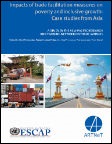 Impacts of Trade Facilitation Measures on Poverty and Inclusive Growth: Case Studies from Asia - A Study by the Asia-Pacific Research and Training Network on TradeThis book addresses the gap between trade facilitation and poverty reduction and contains a compilation of specific case studies that explores the linkages between trade facilitation measures and poverty. It also presents cross-country analysis that examines inequality in low- and middle-income countries. Other chapters discuss economic corridors and microfinance development as trade facilitation measures and examine access to trade facilitation by export-oriented micro, small, and medium-sized enterprises. It also explores barriers to international entrepreneurship for the vegetable business in Bangladesh. Finally, it offers a comprehensive evaluation of the effectiveness of Export Processing Zones (EPZs) on poverty reduction. Author: Ravi Ratnayake, Rajan Sudesh Ratna, Martina Francesca Ferracane and Yann Duval Year: 2013 Download Tags: Trade Facilitation, Bangladesh, Trade, Poverty Reduction, Economic Corridor, Small and medium enterprises, India, SAARC, Customs, Pakistan ADB Regional Cooperation Operations Business Plan (RCOBP) 2014-2016 for South AsiaADB's third Regional Cooperation Operations Business Plan (RCOBP) 2014-2016 for South Asia under its South Asia Regional Cooperation Strategy (RCS) 2011-2015 details a cumulative indicative lending program of $3.3 billion and maintains focus on improved regional connectivity, increased cross-border trade, and strengthened regional economic cooperation. Author: Asian Development Bank Year: 2013 Download Tags: Regional Cooperation, Regional Integration, Bangladesh, Bhutan, India, Maldives, Nepal, Sri Lanka, Trade Facilitation, Transport, Energy, SAARC Regional Integration and Economic Development in South AsiaSouth Asian leaders have made it a priority to tackle key regional issues such as poverty, environment degradation, trade and investment barriers and food insecurity, among others. This book considers the leadership of the South Asian Association for Regional Cooperation (SAARC) and the interaction with civil society in the process of South Asian regional cooperation and integration, and discusses how the emerging urgency in the provision of regional public goods provides an excellent opportunity to add to the successes in South Asian regional integration. Author: Sultan Hafeez / Rahman Sridhar Khatri / Hans-Peter Brunner Year: 2012 Download Tags: Economic Corridor, Regional Cooperation, Regional Integration, SAARC, SAFTA, Bangladesh, Bhutan, India, Maldives, Nepal, Sri Lanka South Asia- Intra Regional Cooperation: The Way ForwardThis study aims to showcase the benefits of regional integration and recommends strategies for overcoming the many hurdles. Author: Shahid Kardar Year: 2011 Download Tags: Policy, Economic Cooperation, Regional Integration, Development, SAARC, Non-Tariff Measures, Trade Facilitation, SAFTA, India, Bangladesh, Bhutan, Maldives, Nepal, Sri Lanka, BIMSTEC, Myanmar, SASEC, Energy 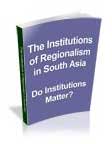 The Institutions of Regionalism in South Asia - Do Institutions Matter?This paper assesses the contribution of key institutions of regional cooperation and integration (RCI) in South Asia, and suggests ways in which the Asian Development Bank and other development partners can strengthen their support. It attempts to enhance understanding on the interplay between politics and RCI, including how good bilateral political relations or improvements have advanced RCI. With the overall political environment growing increasingly open to RCI, the paper suggests the time has come for the South Asian Association for Regional Cooperation (SAARC) to consider strengthening the capacity of the SAARC Secretariat to meet the growing challenges and work load of managing the anticipated increase in RCI. Author: Prabhu Ghate Year: 2011 Download Tags: Regional Cooperation, Regional Integration, Development, SAARC, Trade, Services, Trade Facilitation, Energy, Free Trade Agreements, SAFTA, Bangladesh, Bhutan, India, Maldives, Nepal, Sri Lanka, Transport Energy Trade in South Asia: Opportunities and ChallengesThe South Asia Regional Energy Study was completed as an important component of the regional technical assistance project Preparing the Energy Sector Dialogue and South Asian Association for Regional Cooperation Energy Center Capacity Development. It involved examining regional energy trade opportunities among all the member states of the South Asian Association for Regional Cooperation. The study provides interventions to improve regional energy cooperation in different timescales, including specific infrastructure projects which can be implemented during these periods. Author: Sultan Hafeez Rahman / Priyantha D. C. Wijayatunga / Herath Gunatilake / P. N. Fernando Year: 2011 Download Tags: Energy, Regional Cooperation, Regional Integration, SAARC, Trade, Bangladesh, Bhutan, India, Nepal, Maldives, Sri Lanka Gas Hydrates Resource Potential of South AsiaThe amount of natural gas worldwide is estimated to be greater than the entire world’s conventional natural gas resources, which makes gas hydrates a potential energy resource for the future. This document reviews the status of technology regarding exploration and exploitation of gas hydrates, as well as research initiatives by India and other countries of the South Asian Association for Regional Cooperation (SAARC). It also suggests a mechanism for technology transfer and promotion of research and development in the SAARC region. Author: SAARC Energy Centre Year: 2010 Download Tags: Energy, South Asia, SAARC Quantification of Benefits from Economic Cooperation in South AsiaThe study examines the implication of the South Asian Free Trade Agreement (SAFTA) on South Asian countries and on the region as a whole, employing both a quantitative and qualitative assessment on the outcomes of SAFTA. The research aims to provide support in the formulation of concrete policy measures for trade to ensure greater gains for the region, while at the same time mitigating potential negative impacts. Economic and social assessments through analytical tools and rational causal chain analysis further enrich the study. Author: Asian Development Bank / United Nations Conference on Trade and Development Year: 2008 Download Tags: Economic Corridor, Regional Cooperation, Regional Integration, SAFTA, Free Trade Agreements, Trade Facilitation, Transport, Services, SAARC, Bangladesh, Bhutan, India, Maldives, Nepal, Sri Lanka Emerging Asian Regionalism-A Partnership for Shared ProsperityThe study summarizes important issues related to Asian regionalism. Viewing regional cooperation as a necessary tool for coping with the consequences of interdependence, the book discusses several pressing issues, such as integrating production, improving financial cooperation, and managing macroeconomic interdependence to create a stable architecture for an Asia-wide cooperation. Author: Asian Development Bank Year: 2008 Download Tags: Economic Corridor, Regional Cooperation, Regional Integration, Asia, ASEAN, SAARC, Bangladesh, Bhutan, India, Nepal, Maldives, Sri Lanka |



